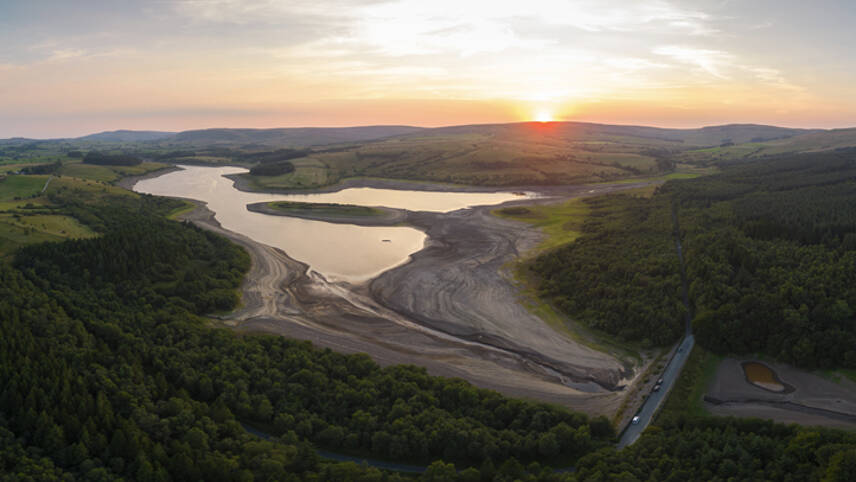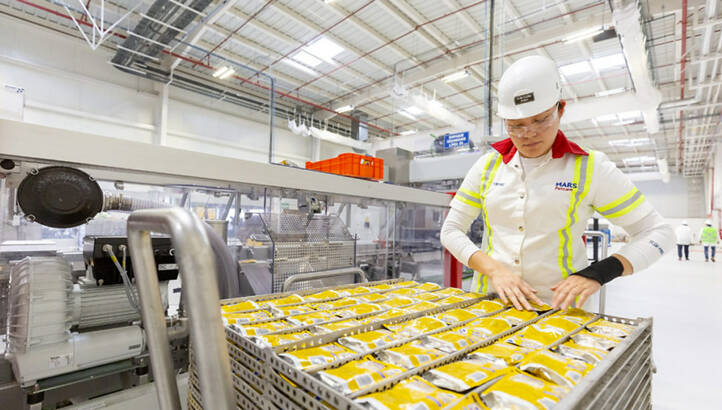Register for free and continue reading
Join our growing army of changemakers and get unlimited access to our premium content

Pictured: Stocks Reservoir, England, amid drought this summer.
Speaking exclusively to edie on a call to mark World Water Week, Mars’s chief climate officer Kevin Rabinovitch says: “We realise that water, unlike climate, is a challenge that must be solved locally. You can solve global carbon balances but not global water flows – you have to go watershed-by-watershed.”
This has been clear to climate and ecosystem experts for some time, with evidence growing clearer by the day. But it has been writ large for all to see this summer.
In the UK, where edie is based, ten English regions and five Welsh regions have officially declared drought. Scotland is also on a rare category ‘red’ water shortage alert. Hot weather, prolonged dry periods and outdated infrastructure contribute to this situation. The picture is even worse in large parts of mainland Europe. More than 60% of the continent is in a drought that the European Commission has called the worst in 500 years.
Drought is also gripping China and northern Mexico in events regarded as the worst on record. Yet other parts of the world, from Seoul to Dallas, have experienced flash flooding this winter, and Pakistan is dealing with a flooding crisis that has submerged one-third of its land.
Put simply, different parts of the world are dealing with very different water challenges, each jeapordising sustainable development efforts.
It is often said that water is life. For large businesses, water is the lifeblood. Companies reporting to CDP disclosed $225bn of value at risk due to water in 2021, but the organisation estimates the figure to be closer to $301bn. So, how are corporate water strategies evolving to fit a world with cascading water-related risks?
Context and science
For several years now, the key facet of corporate water strategies has been setting targets to reduce water use and/or consumption on a global basis.
As water science improves, though, and as the reality of water stress bites in manufacturing and supplier regions across the world, businesses are increasingly setting location-specific goals to account for the localised nature of water challenges. Among the businesses taking this approach are Proctor & Gamble, Suntory, General Mills and Mars – all of which are working with the World Resources Institute (WRI) to develop science-based targets for water.
Mars’ Rabinovitch tells edie that this collaboration is a “natural continuation” for the company, which first began advocating for the development of science-based emissions targets in 2011 and now has goals verified in line with 1.5C by the Science-Based Targets Initiative (SBTi). Building on these targets, Rabinovitch and his team have been striving to align other ambitions with the planetary boundaries framework, looking at a broader array of environmental impacts.
Its current water target is to halve “unsustainable” water usage by 2025 and ensure that all water use is sustainable in the long term. What counts as “sustainable” is determined by the WRI’s data for particular watersheds.
Mars operates 140 manufacturing sites globally across some 100 watersheds. Its commodity supply chains will impact thousands more watersheds. As such, delivering against this target is a complex challenge. Interventions to have been delivered so far include the installation of on-site wastewater treatment systems co-located with anaerobic digestions, with the most recent installation being at the Snickers factory in Waco, Texas.

Pictured: Staff at Mars’s pet food factory in Querétaro, Mexico
The challenge only gets more complex when Mars looks at its supply chain. “As will be true for most food businesses, 98% or more of the water consumed in our value chain is in our raw materials,” Rabinovitch explains.
“When we map our whole supply chain out, much of the water use in water-stressed areas is in a few key commodities: rice, first and foremost; then almonds and mint. There is then a fairly long, but relatively skinny, tail of commodities after that.”
Efficiency first
Another multinational FMCG firm implementing context-specific water targets and striving to improve its scientific grounding is Kimberly-Clark (KC). KC is aiming to halve water use by 2030 against a 2015 baseline, but the target has a “particularly in water-stressed regions” line. In 2021, the company’s water use was 34% lower than in 2015.
KC’s global director of environmental sustainability Jim Bath tells edie that the company operates more than 80 manufacturing sites – 34 of which are in stressed watersheds.
“Of that 34, 13 are tissue manufacturing sites,” Bath explains, “yet those tissue sites account for 90% of our water use in these water-stressed regions. They are fairly evenly split between Latin America, EMEA and the Asia-Pacific regions.
“When you start out the tissue manufacturing process, that sheet is about 90% water and 10% fibre. The whole process after that is about water extraction, until [the sheet] is 97% fibre and 3% embedded water.”
To that end, KC focused on tissue manufacturing sites first when implementing interventions to improve water efficiency and to ensure that used water is cleaned and returned to source as much as possible. For example, the business’s tissue manufacturing site in Santa Cruz, Bolivia, used 86% less water in 2020 than 2015. The reduction within the same timeframe was 68% for its tissue factory in Sitio del Nino, El Salvador.
Several interventions were made to achieve that result. Both sites had new short-loop water recycling systems installed, reducing discharges and increasing internal reuse. Leaks were located and fixed, machinery was retooled and staff engagement programmes were rolled out to change behaviours. Learnings from this process are now being applied to personal care factories in water-stressed regions. And Bath emphasises that, even in non-water-stressed areas, sites “still have an expectation set for continual improvements to water usage”.
While most of Mars’ water use lies in the upstream supply chain, most of KC’s lies in the factories themselves. Both Bath and Rabinovitch emphasise the importance of implementing an efficiency-first approach for value chain hotspots, with the best information available. By being efficient, businesses contribute less to water stress and are also more prepared to continue operating during periods of low water supply.
One water efficiency case study for Mars involves rice cultivation. The firm has been supporting suppliers to forego maintaining continuous standing water in the crop fields, which prevents weeds bedding in but which is very water-intense, in favour of alternate wetting and drying. Also collaborating on this work are the likes of WWF, the UN and the International Rice Research Institute. In some cases, though, sourcing contracts have been ended with suppliers in very high water-risk areas to reduce risk.
Target-setting and collaboration
Delivering against targets is all well and good – until you realise they may have to be changed, as has been the case with corporate emissions goals in the growth in the net-zero movement. This kind of movement is likely on the horizon for water.
In the absence of formalised science-based targets (for the time being), Mars is using the WRI’s existing framework and will fine-tune targets as data improves. KC’s Bath also emphasises the importance of “setting the best target you can with the information you have, then adjusting as you go”.
KC is working with Dutch water research institute Deltares to encourage other water users in operating regions to assess what a “sustainable” level of water use would look like for them. In collaboration, the two organisations have developed a tool called Waterloup, capable of assessing current and future levels of water supply and demand and the potential impact of efficiency, replenishment or refurbishment interventions. The second version of the tool launched last year.
Both men conclude that efficiency from one firm alone cannot solve all water-related challenges. Bath says: “If we’re the only ones doing anything in that watershed, we really haven’t solved the larger problem”.
Both the Deltares and the WRI tools and frameworks can be used by different actors within a watershed. The idea is that, if all actors play their fair part in reducing use, supply and demand can be balanced at sustainable levels. Bath highlights how what constitutes a “fair share” will vary on a location-by-location basis. Some watersheds may already be very stressed, others on the brink. Some may see stress arising from high abstraction for manufacturing, others from animal agriculture, others from cotton. Some may simply need significant improvements to infrastructure, called a refurbishment.
Rabinovitch adds: “On top of water stress, water resilience needs to be thought about as irregularity of water availability becomes more common in some places.”
In other words, watersheds might be preparing for periods of increasingly high demand and low supply – but others will need to prepare for periods of low supply then too much supply, a swinging of the pendulum. Public sector players in stressed watersheds have already been working on this, assessing and creating water storage options, reservoirs and pipes to transport water. This approach is slowly taking shape in historically less water-stressed areas including England, too. Perhaps it is only a matter of time before end-user businesses join these efforts.
This is the first part of a two-part feature. The second half looks at corporate efforts to improve access to water and sanitation, with PepsiCo as a case study. Access it here.


Please login or Register to leave a comment.